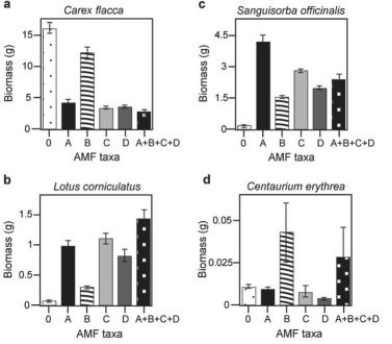There is much discussion in the media about protecting biodiversity. But does biodiversity really matter? Canadian and Swiss researchers wanted to know if the diversity of arbuscular mycorrhizal fungi (AMF) was important to the productivity of grasslands (M.G.A. van der Heijden, J. N. Klironomos, M. Ursic, P. Moutoglis, R. Streitwolf-Engel, T. Boler, A. Wiemken, and I. R. Sanders. 1998. Mycorrhizal fungal diversity determines plant biodiversity, ecosystem variability, and productivity. Nature 396:69-72) . Specifically, they wanted to know if it mattered which specific AMF species were present, or just that some type of AMF was present. They grew various plants in combination with one of four AMF species (A, B, C, and D) , no AMF species (O) , or all four AMF species together (A + B + C + D) ; and they measured plant growth under each set of conditions. All plant species were grown in each plot, so they always competed with each other, with the only difference being which AMF species were present.
On the graphs, the x-axis labels indicate the number and identity of AMF species (bar 0 = no fungi; bars A - D = individual AMF species; bar A + B + C + D = all AMF species together) . The y-axis indicates the amount (grams) of plant biomass for the species shown in italics above each graph. 
-Examine all four graphs and choose the plant species that grows best with a combination of AMF species.
Definitions:
Problem Solving Styles
The characteristic approaches and methods individuals employ when faced with challenges or tasks requiring solutions.
Different Styles
Variations in approaches, techniques, or methods applied in various contexts, such as management, communication, or leadership.
Living or Working Together
involves sharing a living or workspace with others, requiring cooperation, communication, and mutual respect to manage coexistence harmoniously.
Illusion of Unanimity
The perception that everyone agrees when in reality, they do not, often occurring in group settings.
Q5: The phase change of an apical meristem
Q8: Based on cladistics, which eukaryotic kingdom is
Q28: Which of the following could be considered
Q48: This student has probably found a _.<br>A)
Q51: A P. bursaria cell that has lost
Q53: In order for an ovule (egg cell)
Q61: Which of the following sex and generation
Q62: Which of the following statements about the
Q69: In a hypothetical situation, the genes for
Q75: Water's density and, consequently, its buoyancy decrease